Cardiff pond maintenance, Carlsbad pond maintenance, Carmel Valley pond maintenance, Del Mar pond maintenance, Encinitas pond maintenance, La Costa pond maintenance, LaJolla pond maintenance, Leucadia pond maintenance, North County pond maintenance, Point Loma pond maintenance, Poway pond maintenance, Rancho Santa Fe pond maintenance, San Diego pond maintenance, and San Marcos pond Maintenance. North County Ponds and Rancho Santa Fe pond service. North County Ponds 760-710-1632 P.O. Box 8053 Rancho Santa Fe, California 92067. North County Ponds is north San Diego's best pond cleaning and pond maintenance service pond cleaning service. For a clean, healthy, beautiful pond, our pond maintenance is second to none. We are pond service professionals and are passionate about clean, healthy koi ponds. Let North County Ponds care for your koi pond. Keep your pond beautiful! Call us today for a free pond consultation: North County Ponds (760-710-1632) Dirty pond? North County Ponds is the answer for clearer, cleaner pond water, pond muck removal, aquatic plant management, pond algae control, pond filter and pond pump maintenance, pond equipment installation, koi health, pond health, and general pond and lake management. North County Ponds services the greater area of north San Diego county including: Rancho Santa Fe ponds, Del Mar ponds, La Jolla ponds, Carmel Valley ponds, Solana Beach ponds, Encinitas ponds, Carlsbad ponds, and Fallbrook ponds. |
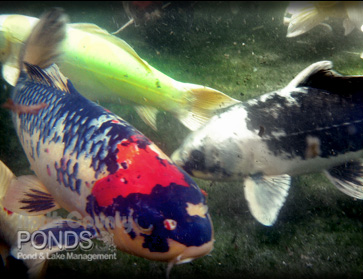 |
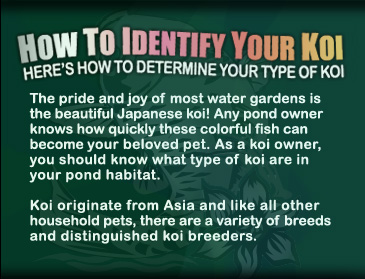 |
 |
|
|
 |
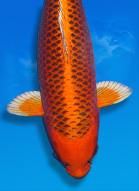 |
 |
| Matt-scaled Matsuba are grouped in Kawarimono, but their metallic equivalents are benched Hikarimono. The most commonly available are Kin Matsuba (metallic gold/yellow, first produced in 1960) and the Gin Matsuba, its silver equivalent. Platinum (white) Matsuba and Aka Matsuba Ogon are not often seen. The pinecone scalation must be pronounced; if the black is more of a gray, these koi look washed out. Beginners are often confused by the Doitsu Matsuba Ogon, as the scale reticulation is not present. Instead, the black, German scales are aligned in the usual position, where they contrast sharply with the metallic body. Orange Doitsu Ogonare very rare. |
 |
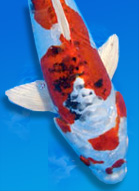 |
 |
| The aristocrat of Hikarimoyo is the metallic Sanke known as Yamatonishiki. This variety came on to the market in the 1960s from two distinct sources, the first breeder being Seikichi Hoshino, who took 15 years to develop it. The complex process involved an initial cross between an Asagi and a Kin Kabuto and subsequent introductions of Sakura Ogon blood. A similar fish - Koshi-nishiki - was bred in Yamakoshi by crossing a Yamabuki Doitsu with a Gin Showa. Both are now grouped together as Yamatonishiki. |
 |
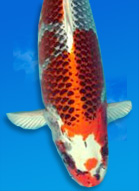 |
 |
| Kujaku are highly regarded by the Japanese, as the patterning on a good specimen can rival that of Sanke. Like Goshiki, they are said to be five-colored koi. The first ones were bred in Ojiya in 1960 by Toshio Hirasawa from a female Shusui and a male Kin Matsuba and Hariwake. (Koi are normally spawned in trios, with one female and two males. It is therefore impossible to establish the exact parentage of the first Kujaku.) The result was a metallic platinum fish with black Matsuba scalation overlaying a hi pattern, a clear red head, and some blue derived from the original female parent koi. Many of these first Kujaku (the word literally means "peacock") were Doitsu, again the result of the Shusui influence. |
 |
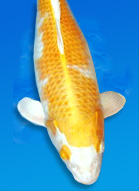 |
 |
| Hariwake are derived from Ogon or Ogon Matsuba lineage and display two metallic colors - a platinum base overlaid with either yellow-gold (Yamabuki) or orange (Orenji) markings. These immensely bright and showy koi, much loved be beginners, are relatively easy to produce. The Doitsu versions are particularly popular. Ideally Hariwake should have clear platinum heads, although if the second color intrudes it is not a disaster. The nicest examples show a lot of metallic white on the body, but others have only small areas of this platinum skin. As in Hikarimono, the scales should convey a three-dimentional impression. |
 |
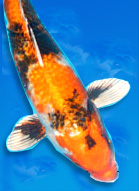 |
 |
| Metallic Showa are the result of crossing Showa and Utsurimono with Ogon. These koi breeds have become rare since they were first introduced and now are often underrepresented at shows for a few reasons. First, subtle appreciation of the finer points of koi is spreading from Japan to other parts of the world, and serious hobbyists are moving away from the flashier varieties to the more original, classic style koi. Second, while the metallic luster of Hikariutsuri is a plus, it has a tendency to tone down hi and sumi, so although these koi sparkle in the pond, their patterning is not always clear-cut or deep in color. This makes koi that overcome this potential drawback very valuable, and efforts have indeed been made to improve the overall quality of Hikariutsuri by back-crossing to their original, nonmetallic half of the partnership. |
|
|
|
 |
| If your pond is new or old, large or small, North County Ponds is trained in a variety of pond care services including regular pond maintenance, on-call pond services, pond clean-outs, complete filter system installs, pond water treatments, system cleanings, pond sealing, koi medicating, koi and fish care, algae control, aquatic plant care, and all other aspects of pond and lake management. Call North County Ponds at 760-710-1632 for questions, pricing info, or to schedule a free pond consultation. |
 |
|
| Cardiff pond maintenance, Carlsbad pond maintenance, Carmel Valley pond maintenance, Del Mar pond maintenance, Encinitas pond maintenance, La Costa pond maintenance, LaJolla pond maintenance, Leucadia pond maintenance, North County pond maintenance, Point Loma pond maintenance, Poway pond maintenance, Rancho Santa Fe pond maintenance, San Diego pond maintenance, and San Marcos pond Maintenance. North County Ponds and Rancho Santa Fe pond service. North County Ponds 760-710-1632 P.O. Box 8053 Rancho Santa Fe, California 92067. North County Ponds is north San Diego's best pond cleaning and pond maintenance service pond cleaning service. For a clean, healthy, beautiful pond, our pond maintenance is second to none. We are pond service professionals and are passionate about clean, healthy koi ponds. Let North County Ponds care for your koi pond. Keep your pond beautiful! Call us today for a free pond consultation: North County Ponds (760-710-1632) Dirty pond? North County Ponds is the answer for clearer, cleaner pond water, pond muck removal, aquatic plant management, pond algae control, pond filter and pond pump maintenance, pond equipment installation, koi health, pond health, and general pond and lake management. North County Ponds services the greater area of north San Diego county including: Rancho Santa Fe ponds, Del Mar ponds, La Jolla ponds, Carmel Valley ponds, Solana Beach ponds, Encinitas ponds, Carlsbad ponds, and Fallbrook ponds. |








